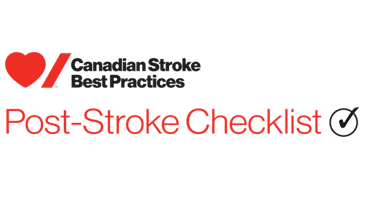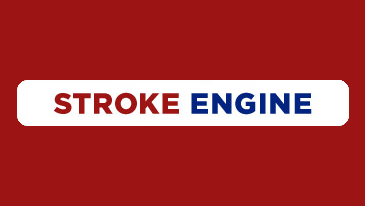- Definitions
- 1. Stroke Awareness, Recognition, and Response
- 2. Triage and Initial Diagnostic Evaluation of Transient Ischemic Attack and Non-Disabling Stroke
- 3. Emergency Medical Services Management of Acute Stroke Patients
- 4. Emergency Department Evaluation and Management of Patients with Acute Stroke and TIA
- 5. Acute Ischemic Stroke Treatment
- 6. Acute Antithrombotic Therapy
- 7. Early Management of Patients Considered for Hemicraniectomy
- 8. Acute Stroke Unit Care
- 9. Inpatient Prevention and Management of Complications following Stroke
- 10. Advanced Care Planning
- 11. Palliative and End of Life Care
Acute Stroke Management
7th Edition UPDATE – December 2022 & Endovascular Thrombectomy Interim Update 2025
The CSBPR Acute Stroke Management module provides guidance to healthcare providers caring for people who present to the healthcare system with current or very recent symptoms of acute stroke or transient ischemic attack (TIA). This module also addresses the issue of public and healthcare providers’ recognition of the signs of stroke and immediate actions that should be taken, including contacting emergency medical services (EMS), arriving at a stroke-enabled emergency department, and launching local healthcare institution code stroke protocols.
This module is presented in two parts. Part 1 addresses prehospital and emergency management of acute stroke, while Part 2 addresses acute inpatient stroke care (Figure 1).
- Sections 1 to 7 in the Acute Stroke Management module address prehospital and emergency department stroke care. This encompasses all direct care, investigations, interventions, service delivery, and interactions from first contact with the healthcare system after the onset of an acute stroke or TIA (usually by contacting EMS or presenting at a healthcare facility) through to discharge from an emergency department to another healthcare facility (usually with a higher or lower level of stroke care), an acute inpatient care unit, or the community. Sections 1 to 4 apply to all potential patients with stroke arriving at hospital; sections 5 and 6 are specific to people experiencing an acute ischemic stroke; and section 7 applies to all confirmed stroke and TIA patients.
- Sections 8 to 11 address acute inpatient stroke care. This encompasses all direct care, investigations, interventions, service delivery, and interactions from the time a person with stroke is admitted to an acute care hospital.
With each update of the Canadian Stroke Best Practice modules, the most current evidence on the included topics is reviewed by the writing group members and internal and external reviewers. Recommendations from the previous edition may be continued unchanged, modified to reflect updated evidence (either wording or evidence levels), or removed. New recommendations may be added to address emerging evidence and practice changes.
Acute Stroke Management Module, 7th Edition, 2022:
The following are the most notable areas that have been added or significantly revised in this 7th edition of the CSBPR Acute Stroke Management module.
- Sex and gender considerations: Specific attention has been given to potential differences in care and outcomes of acute stroke based on sex and gender. We are mindful that sex (a collection of biological attributes) and gender (a psycho-social construct related to our identity), may affect stroke care and outcomes differently; however, it is recognized that gender is not binary and that the literature, until recent years, used the terms gender and sex interchangeably in publications, and there are few current studies that differentiate between sex and gender. The terms “men” and “women” are used throughout the guideline to refer to people of male and female sex, with an appreciation that the gender constructs may have additional impacts and that this is an area requiring further research and reporting requirements.
- Evidence rating scale: Changed from the previous scale of A, B, C to the scale applied within the Grading of Recommendations, Assessment, Development and Evaluations (GRADE) methodology.
- Imaging: All recommendations related to imaging in the early phase of acute stroke have been consolidated into Section 4.
- Addition of tenecteplase: Based on new clinical trial evidence released in 2022, new recommendations for the use of tenecteplase (TNK) as an alternative to alteplase for acute intravenous thrombolysis has been added to Section 5.
- Symptomatic intracranial hemorrhage (sICH): New recommendations have been included in Section 5 on management of sICH following administration of intravenous thrombolysis.
- Pre- and post- endovascular thrombectomy care: New clinical practice guidance has been included in Section 5, Box 5D on the care of people undergoing EVT, pre and post procedure.
- Combined intravenous thrombolysis and EVT: A new clinical consideration has been added to Section 5 to address recent trials regarding combined therapy versus EVT alone, reflecting the current uncertainty in the evidence.
- Dual antiplatelet therapy: New recommendations have been added to Section 6 regarding the use of dual antiplatelet therapy (DAPT) in people who have experienced an acute ischemic stroke. These new recommendations are aligned with recommendations in the CSBPR Secondary Prevention of Stroke module, 2020.
- Medical Assistance in Dying (MAiD): New statements have been added to Section 11 regarding discussions about MAiD with appropriate patients and family members.
- Virtual care: New and updated recommendations for virtual stroke care in the emergency department and inpatient care have been added to Sections 4, 5, and 9 to reflect the sustainable integration of this modality into daily care for people with stroke.
- Mobile stroke units: A clinical consideration has been added to Section 3 on the use of mobile stroke units.
NEW FOR 2025:
Endovascular Thrombectomy for Acute Ischemic Stroke, Interim Update 2025
- Recommendations have been updated to address emerging evidence related to posterior circulation stroke, stroke with large core, and stroke with medium vessel occlusion (MeVO). These changes include: updating section 5.4 and removal of boxes: 4B, 4C, 5C.
The detailed methodology and explanations for each of these steps in the development and dissemination of the CSBPR is available in the Canadian Stroke Best Practice Recommendations Overview and Methodology manual.
Conflicts of interest
All potential participants in the recommendation development and review process are required to complete confidentiality agreements and declare all actual and potential conflicts of interest prior to participation. Declared conflicts of interest are reviewed by the co-chairs of the CSBPR Advisory Committee and Heart & Stroke staff to assess the potential impact. Those with significant conflicts with respect to the module topic are not selected for writing group or reviewer roles. Participants who have conflicts for a particular topic area are identified at the beginning of discussions for that topic and are recused from voting. If a co-chair is in conflict, they are recused from their responsibilities for that discussion and another non-conflicted participant assumes the role for that discussion and vote. Heart & Stroke senior staff members participate in all writing group discussions and intervene if they perceive an untoward bias by a writing group member. Conflict of interest declarations for the Acute Stroke Management module writing group members can be found in Appendix 1.
Heart & Stroke gratefully acknowledges the Acute Stroke Management writing group leaders and members, all of whom have volunteered their time and expertise to the update of these recommendations. Members of the Canadian Stroke Consortium were involved in all aspects of the development of these recommendations. The recommendations underwent external review by: Philip A Barber, Treena Bilous, Renee Denise Cashin, Luciana Catanese, Seemant Chaturvedi, Michael Chow, Adam A. Dmytriw, Ian Drennan, Claire Dyason, Barb Field, Romayne Gallagher Peter A. Gooderham, M. Shazam Hussain, Ebru Kaya, Katie Lin, Gordon McDonald, Stefan Pagliuso, Trudy Robertson, Julie Savoie, Joanna Schaafsma, Brenda Semenko, Ravinder Jeet Singh, Sean William Taylor, Aleksander Tkatch, Jenny P. Tsai, Gregory Brett Walker and Hope Weisenberg.
We thank the Canadian Stroke Best Practices and Quality Advisory Committee members: Eric E. Smith (Co-Chair), Anita Mountain (Co-Chair), Aline Bourgoin, Gord Gubitz, Dar Dowlatshahi, Dylan Blacquiere, Margie Burns, Louise Clement, Thalia Field, Farrell Leibovitch, Christine Papoushek, Jeffrey Habert, Joyce Fung, Michael D Hill, Eddy Lang, Pascale Lavoie, Beth Linkewich, Colleen O’Connell, Jai Shankar, Debbie Timpson, Theodore Wein, and Katie White. The performance measures were reviewed and updated by the Heart & Stroke health systems quality council including Amy Yu (Chair), Michael Hill, Aravind Ganesh, Sacha Arsenault, Christine Hawkes, Jessalyn Holodinsky, Raed Joundi, Laura Gioia, Noreen Kamal, Shannon MacDonald, Katharine Mckeen, Kathryn Yearwood, Leigh Botly, and Laura Holder.
We acknowledge and thank Norine Foley and the evidence analysis team at workHORSE; Shelley Sharp and Trish Helm-Neima for the review of Acute Stroke Management Performance Measures; Adrian Salonga for writing group participation and contributions, Laurie Charest of Heart & Stroke for her coordination of the CSBPR teams and processes; and Francine Forget Marin and the Heart & Stroke internal teams who contributed to the development and publication of these recommendations (Translation, Communications, Knowledge Translation, Engagement, Health Policy, and Digital Solutions).
Endovascular Thrombectomy for Acute Ischemic Stroke, Interim Update 2025
Heart & Stroke gratefully acknowledges the Acute Stroke Management writing group leaders and members, all of whom have volunteered their time and expertise to the update of these recommendations. Members of the Canadian Stroke Consortium were involved in all aspects of the development of these recommendations. We acknowledge and thank Dr. M. Patrice Lindsay, the lead writer and senior editor of this module and manuscript. She is acknowledged for her expertise and efforts with significant contributions in all aspects of scientific literature review, guideline development, writing group deliberations, internal and external review process, and manuscript preparation. We acknowledge and thank Norine Foley and the evidence analysis team at workHORSE. These recommendations underwent external review by Andrew Demchuk, Jai Shankar, Michael Kelly and Robert Fahed. The Heart & Stroke internal teams contributed to the dissemination and publication of these recommendations (Translation, Communications, Knowledge Translation, Lived Experience Engagement Support, Health Systems, and Digital Solutions).
Community Consultation and Review Panel
Heart & Stroke is especially grateful to the members of the Community Consultation and Review Panel who reviewed this module and shared their personal experiences and insights on what made or could have made their journey easier. CCRP members included: Ashley Voth, Sarah Blanchard-Eng, Allan Morrison, Patricia Pollock, Heather Purvis, Donna Sharman, Andy Sharman, and Louise Nichol.
Manraj Heran (Co-Chair, First Author), M. Patrice Lindsay (Corresponding Author), Gord Gubitz, Amy Yu, Aravind Ganesh, Rebecca Lund, Sacha Arsenault, Doug Bickford, Donnita Derbyshire, Shannon Doucette, Esseddeeg Ghrooda, Devin Harris, Nick Kanya-Forstner, Eric Kaplovitch, Zachary Liederman, Shauna Martiniuk, Marie McClelland, Genevieve Milot, Jeffrey Minuk, Erica Otto, Jeffrey Perry, Rob Schlamp, Donatella Tampieri, Brian van Adel, David Volders, Ruth Whelan, Samuel Yip, Norine Foley, Eric E. Smith, Dar Dowlatshahi, Anita Mountain, Michael D Hill, Chelsy Martin, and Michel Shamy (Co-Chair, Senior Author); on Behalf of the Canadian Stroke Best Practice Recommendations Advisory Committee, in collaboration with the Canadian Stroke Consortium. Canadian Stroke Best Practice Recommendations: Acute Stroke Management, 7th Edition, 2022; Toronto, Ontario, Canada: Heart and Stroke Foundation. In M. Patrice Lindsay, Anita Mountain, Rebecca Lund, Chelsy Martin, Gord Gubitz, Amy Yu, Dar Dowlatshahi, and Eric E. Smith (Editors), on behalf of the Canadian Stroke Best Practices and Advisory Committee in collaboration with the Canadian Stroke Consortium. Canadian Stroke Best Practice Recommendations, 7th edition, 2022; Toronto, Ontario, Canada: Heart and Stroke Foundation of Canada.
Manraj KS Heran (Co-Chair), David Volders, M. Patrice Lindsay (Senior Editor and co-writer), Michael D Hill, Dylan Blacquiere (Advisory Co-Chair), Gord Gubitz, Norine Foley, Rebecca Lund, Anita Mountain (Advisory Co-Chair), and Michel Shamy (Co-Chair), on behalf of the Canadian Stroke Best Practice Recommendations Advisory Committee, CSBPR Acute Stroke Care writing group, in collaboration with the Canadian Stroke Consortium and the Canadian Neurological Sciences Federation. Canadian Stroke Best Practice Recommendations Endovascular Thrombectomy for Acute Ischemic Stroke, Interim Update 2025; Toronto, Ontario, Canada: Heart and Stroke Foundation.
- Acute Stroke Management guideline publication
- Endovascular Thrombectomy for Acute Ischemic Stroke, Interim Update 2025 publication
- Writing Group Members and External Reviewers, (Appendices 1 & 2)
- Figure One: CSBPR Acute Stroke Management Topics
- Figure Two: Acute Stroke Service Capability
- Acute Stroke Management Definitions
- Sex and Gender Considerations Reference List
Part 1: Prehospital and Emergency Department Stroke Care Recommendations
1. Stroke Awareness, Recognition, and Response Recommendations
- Box 1A: FAST Signs of Stroke
- Box 1B: Core Information Required by Emergency Medical Services Dispatch, Paramedics and Receiving Healthcare Facility
- Evidence Table and Reference List 1
- Table 2A: Recommended Laboratory Investigations for Patients with Acute Stroke of Transient Ischemic Attack
- Evidence Table and Reference List 2
3. Emergency Medical Services Management of Acute Stroke Patients Recommendations
- Box 3A: Core Information Required by Dispatch, Emergency Medical Services, and Receiving Healthcare Facility
- Box 3B: Considerations in EMS Transport Decisions
- Evidence Table and Reference List 3
- Box 4A: Exclusion Criteria for IV Thrombolysis Selection Imaging: CT Findings
- Evidence Table and Reference List 4: Emergency Department Evaluation and Management of Patients with TIA and Acute Stroke
- Evidence Table and Reference List 4B: Emergency Department Evaluation and Management of Patients with TIA and Acute Stroke – Imaging
- Evidence Table and Reference List 4C: Virtual Care
5. Acute Ischemic Stroke Treatment Recommendations
- Box 5A: Time Windows for Reperfusion in Acute Ischemic Stroke
- Box 5B: Criteria for Intravenous Thrombolysis Treatment
- Box 5D: Pre- and Post- Management of Patients Undergoing Endovascular Thrombectomy
- Evidence Table and Reference List 5: Acute Ischemic Stroke Treatment – Thrombolytic Therapy
- Evidence Table and Reference List 5B: Acute Ischemic Stroke Treatment – Endovascular Therapy
6. Acute Antithrombotic Therapy Recommendations
7. Early Management of Patients Considered for Hemicraniectomy Recommendations
Part 2: Acute Inpatient Stroke Care
8. Acute Stroke Unit Care Recommendations
- Box 8A: Optimal Acute Inpatient Stroke Care
- Evidence Table and Reference List 8
9. Inpatient Prevention and Management of Complications Recommendations
10. Advance Care Planning Recommendations
11. Palliative and End-of-Life Care Recommendations
Appendix One: Canadian Stroke Best Practice Recommendations - Acute Stroke Management Writing Group
Appendix Two: Canadian Stroke Best Practice Recommendations - Acute Stroke Management External Reviewers
Appendix Three: Table of Tools
- Table 3a: Standardized Acute PreHospital Stroke Screening Tools
- Table 3b: Additional Tools
- Table 3c: Prehospital Stroke Screening Scales to Identify Large Vessel Occlusions (LVO)
- Table 4: Canadian Stroke Best Practices Screening and Assessment Tools for Acute Stroke Severity
- Table 5: Canadian Stroke Best Practices: Selection of Validated Swallowing Screening Tools





